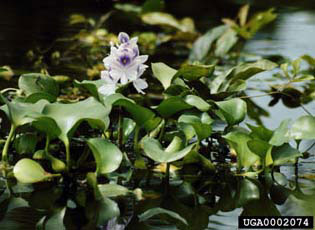
INVASIVE ALERT: THREATS TO MICHIGAN’S WETLANDS
Nearly 5.5 million acres of Michigan’s landscape are considered wetland, which is roughly 15% of the land area of the state. With increasing reports of water hyacinth, an aquatic plant that has highly problematic invasive tendencies, this just increases our concern for all the threats to critical wetland habitat.

Plants at Mara River – Ted D. Center
USDA, Agricultural Research Service
Invasive.org.
Water hyacinth (WH) was originally native to South America and was imported into the United States for sale in the aquarium trade, which is its most likely cause of spread. Over the last 30 years, the plant has managed to spread to nearly 30 states and is still commercially available in 7, including Michigan, with several cases confirmed in many different locations across Southern Michigan. It can be found in marshes, swamps, ditches, lakes, and rivers. This poses serious threats to our wetlands.
Water hyacinth is a free-floating aquatic plant that produces attractive purple flowers, which has helped promote its sale as a water garden plant. The plant forms dense vegetative mats that can cover large expanses of open water with green, waxy, cup-like leaves. Their ability to float stems from a distinctive air bladder located on the leaves. The stems have the ability to grow up to 2 feet and produce clusters of 8-15 purple flowers. The purple flowers tend to bloom mid-summer and are very similar in appearance to the native terrestrial irises.
Water hyacinth has the ability to nearly double its population size in 2 weeks, and since the plants primary means of reproduction are through the fragmentation of stolon’s, or breaks along the horizontal stems, which create new growth, the plant has been deemed one of the most problematic in the world. With its ability to produce dense, thick mats, WH shades out native plants and aquatic vegetation, which reduces important structures for fish and native wildlife.
With wetland habitat declining across Michigan, it’s safe to say water hyacinth is a contributing factor, and the environments in which water hyacinth grows are critical for conservation of waterfowl and other wetland associated species. Not only does this degrade our wetland habitats in Michigan, it can also put a damper on waterfowl hunting, trapping, kayaking, and other water-based activities.
Preventing the spread of water hyacinth is our front line to protecting Michigan’s wetlands. According to one assessment of natural ecosystems, the dollar value of wetlands worldwide was estimated to be $14.9 trillion (Costanza et al. 1997). So it is our responsibility to protect the wetlands we have and make sure they continue to thrive. By not purchasing water hyacinth, keeping your hunting, fishing and trapping gear clean, proper disposal of aquarium and water garden plants, and not transporting organisms or ballast water between water bodies, you are helping prevent this threat from spreading, and Michigan’s native species thank you for that!
This article is part of the ongoing series on invasive species funded in part with funds from the Michigan Invasive Species Grant Program through the Departments of Natural Resources, Environmental Quality, and Agriculture and Rural Development
